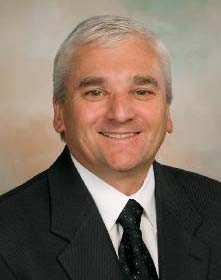David McBride Named Acting Director Of Flight Research
Center
 Kevin L. Petersen, director of
NASA's Dryden Flight Research Center, announced this week he plans
to retire from NASA, effective April 3. A veteran aerospace
engineer and manager with 38 years experience at NASA Dryden,
Petersen has served as the center's director for more than 10 years
and is the longest-serving field center director currently at
NASA.
Kevin L. Petersen, director of
NASA's Dryden Flight Research Center, announced this week he plans
to retire from NASA, effective April 3. A veteran aerospace
engineer and manager with 38 years experience at NASA Dryden,
Petersen has served as the center's director for more than 10 years
and is the longest-serving field center director currently at
NASA.
Dryden's deputy center director, David D. McBride, has been
named acting director.
"Kevin's service to NASA exemplifies what's great about the
people who make up America's space program -- he's served with
distinction and helped lead the agency aeronautics efforts into the
21st century," said NASA Acting Administrator Chris Scolese. "I've
asked David McBride to serve as acting Dryden director. I'm
confident David will help keep Dryden in the forefront of
aeronautics research during this period of transition."
During Petersen's tenure as center director, NASA Dryden has
been transformed from a field center primarily focused on
aeronautics research and support for the space shuttle program to
its present state with major projects supporting all four of NASA's
mission disciplines -- environmental and space science, space
exploration, human spaceflight and aeronautics.
During the last decade, Dryden has accomplished many
flight-research "firsts," including the flight of the Helios
solar-electric aircraft to a world record 96,863 feet altitude, the
flight of the X-43A integrated scramjet vehicle to a speed of Mach
10, and the demonstration of fully autonomous in-flight aerial
refueling capability.
"It's hard to imagine a career with more excitement and
opportunity," said Petersen. "Dryden is a unique place with
unmatched talents and capabilities. It has been a privilege and an
honor to have played a small role in Dryden's historic
accomplishments."
Petersen began his career at NASA Dryden as a university
cooperative student in 1971 and was hired as an aerospace engineer
upon graduation in 1974. Early in his career at Dryden, Petersen
worked as a research engineer on the three-eighths-scale F-15
Remotely Piloted Research Vehicle, the F 8 Digital Fly By Wire and
the Highly Maneuverable Aircraft Technology projects.
He later served in multiple supervisory and management positions
at Dryden within the Research Engineering Division. He provided
multidisciplinary support to a variety of research programs in
flight dynamics and controls, structural dynamics, and flight
systems. Programs he supported included the F-18 High Angle of
Attack Research Vehicle and the X 29 Forward Swept Wing technology
demonstrator aircraft, for which he was chief engineer.
Petersen headed the center's National AeroSpace Plane project
office from February 1992 through November 1993. He was then
selected to be the center's acting deputy director and was
appointed Dryden's deputy director January 1996.
Upon the retirement of former center director Ken Szalai,
Petersen was named the center's director on February 9, 1999.

Petersen was awarded NASA's Exceptional Achievement Medal in
2004 for his contributions to the agency. He also has been the
recipient of NASA's Exceptional Engineering Achievement Medal,
NASA's Exceptional Service Medal, NASA's Outstanding Leadership
Medal and NASA's Equal Employment Opportunity Medal.
Petersen holds both bachelor's and master's degrees in aerospace
engineering. He is a fellow of the American Institute of
Aeronautics and Astronautics.
 ANN's Daily Aero-Linx (04.16.24)
ANN's Daily Aero-Linx (04.16.24) Aero-News: Quote of the Day (04.16.24)
Aero-News: Quote of the Day (04.16.24) Airborne 04.10.24: SnF24!, A50 Heritage Reveal, HeliCycle!, Montaer MC-01
Airborne 04.10.24: SnF24!, A50 Heritage Reveal, HeliCycle!, Montaer MC-01 Airborne 04.12.24: SnF24!, G100UL Is Here, Holy Micro, Plane Tags
Airborne 04.12.24: SnF24!, G100UL Is Here, Holy Micro, Plane Tags Airborne-Flight Training 04.17.24: Feds Need Controllers, Spirit Delay, Redbird
Airborne-Flight Training 04.17.24: Feds Need Controllers, Spirit Delay, Redbird




